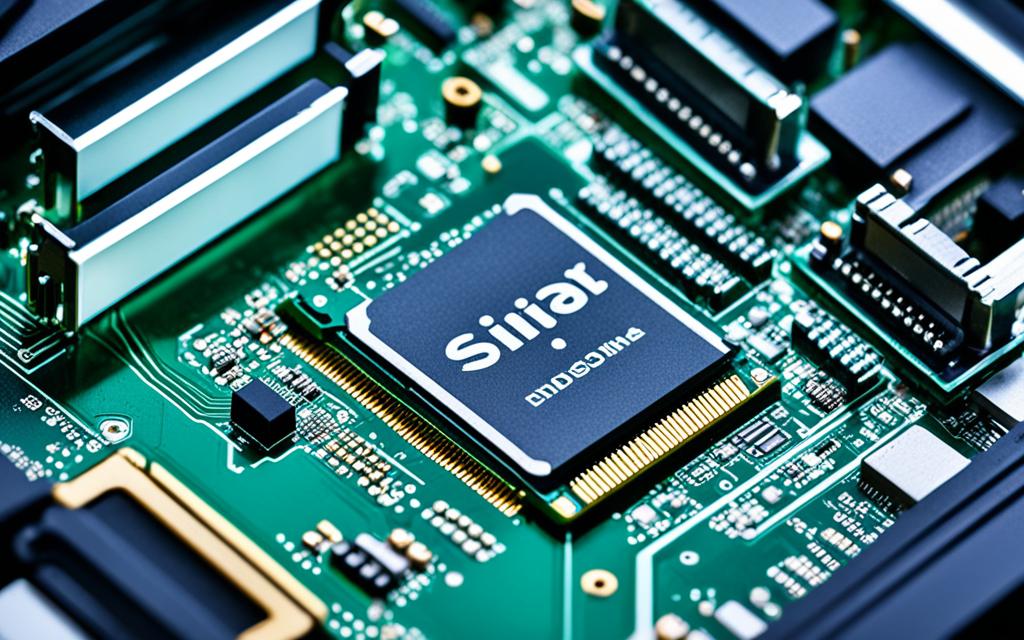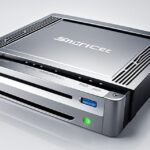Table of Contents
Finding out the type of storage device in your computer is key. It helps in boosting its speed, solving problems, or when thinking about making enhancements. SSDs have become the go-to because of their fast operation and dependability, unlike the old hard drives1.This is why knowing your SSD type is important. It gives you a clear view of your system’s strength and how long it might last2.Older models might not have SSDs, but most new ones, especially Macs, do. In this article, you’ll learn different ways to figure out the SSD you have, whether you’re using a Windows PC or a Mac3. This knowledge will help you make smarter choices about your device’s storage.
Key Takeaways
- Understanding if you have an SSD or HDD is crucial for system performance.
- Most modern devices, including Chromebooks and Macs, primarily utilise SSDs for their enhanced speed.
- Utilising built-in tools on Windows, such to as check your SSD type.
- macOS offers straightforward methods for identifying storage devices through the ‘About This Mac’ feature.
- Third-party software can provide in-depth information on your SSD’s health and specifications.
- Accessing BIOS is a reliable option for identifying storage devices, especially when booting issues arise.
Understanding SSDs and HDDs
The world of digital storage includes SSDs and HDDs as main options. Getting to know the SSD vs HDD difference is key if you’re picking storage. Each offers distinct features, but they vary greatly in how they work and perform.
Key Differences Between SSDs and HDDs
SSDs use flash memory, making them faster. Unlike SSDs, HDDs use spinning disks, which slows them down. SSDs can copy files very fast, from 500 MBps to 3,500 MBps4.
HDDs are slower, transferring data at just 30–150 MBps4. Their technology also causes slower access times. HDDs can only manage speeds between 0.1–1.7 MBps compared to SSDs’ 50–250 MBps4. Because HDDs’ disks spin slower, at 4200–7200 RPM, they can’t match SSD speed4.
The Benefits of Using an SSD
Going for an SSD brings many pros. They’re lighter and save more energy, leading to less heat and longer life5. You’ll notice a big difference in how quick applications, games, and videos load with an SSD5.
SSDs do cost more than HDDs, about 2.5 times higher. However, their speed and reliability offer great value for the price5. It’s important to think carefully about your storage needs. The choice you make affects your system’s performance and efficiency greatly.
How to See What SSD I Have on Windows
Knowing which SSD you have can help you understand your PC’s performance and plan upgrades. There are a few simple tools in Windows to help you find out about your SSD. These tools make it easy to see your SSD details.
Using the Defragment and Optimise Drives Tool
The Defragment and Optimise Drives tool is simple to use. Just open the utility and select your drive. Look at the “Media Pype” column to see if your drive is an SSD or a Hard Drive6.
This method is great for figuring out the type of drive you have. SSDs are becoming more common because they access data faster and have no moving parts7.
Checking Through Device Manager
The Device Manager lets you see if you have an SSD easily. You can see each drive’s full name, helping you tell SSDs apart from HDDs6.
It also shows model names and more details. These details help with planning upgrades or troubleshooting7.
Utilising Windows PowerShell
Windows PowerShell is for those wanting more detail. A command like Get-PhysicalDisk | Format-Table -AutoSize brings up a list. It shows if a drive is an HDD or an SSD6.
This gives you precise information such as serial numbers and the type of bus8.
Disk Management Utility
The Disk Management utility helps identify your Windows SSD. Look for the drive marked with the Windows logo. This simple step confirms which drive Windows is on37.
Using this tool and others mentioned, you can make smart choices about your SSD. This can lead to better performance8.
Identifying Your SSD on macOS
It’s key to know what storage drive your Mac uses to understand its speed and keep it working well. If you want to check the SSD on your macOS, it’s easy to do and tells you a lot about what your Mac can do.
About This Mac Overview
To start, click the Apple logo at the top left and choose “About This Mac.” This shows your Mac’s details. In this summary, click the “Storage” tab. It tells you about the drives in your Mac, including if you have an SSD.
Storage Details in macOS
The “Storage” tab presents your storage in a clear way, showing how much space is taken. If you see an SSD listed, you know your Mac uses a faster, more modern drive9. SSDs are quick, offering speeds up to 13,000 MB/s. This is much faster than older HDDs, which max out at about 500 MB/s10.
SMART technology on macOS checks if your SSD is working well. It alerts you to any possible problems9. A good SMART status means your SSD is in top shape, helping it last longer.
| Attribute | SSD | HDD |
|---|---|---|
| Speed | Up to 13,000 MB/s | Around 500 MB/s |
| Lifespan | 5 to 10 years | 3 to 5 years |
| Power Consumption | 2 W | About 8 W |
| Cost per GB | $0.08 to $0.12 | $0.03 to $0.06 |
| Storage Capacity | Up to 15 TB | Up to 20 TB |
Keeping an eye on your SSD’s health can make it last longer. This means a smoother, quicker computer for you. Cleaning your Mac’s memory helps too9.
Utilising Third-Party Software for SSD Identification
For a deeper understanding of your SSDs, third-party software is invaluable. Tools like HWiNFO64 stand out due to their detailed insights. They offer info on system hardware, drives, and their features.
Benefits of Using HWiNFO64
HWiNFO64 monitors your hardware in real-time. It lets you see your SSD’s performance, including temperature and speeds. This helps spot problems early, keeping your data safe and reliable over time11.
Exploring Other Recommended Applications
Other apps like CrystalDiskInfo and SSD-Z are also great for SSD check-ups. They have simple interfaces for all users. Use them to find out if you have an SSD, NVMe, or HDD, and get important health info. These tools help you know your drives better, aiding in smarter storage decisions12.
| Software | Features | Key Benefits |
|---|---|---|
| HWiNFO64 | Comprehensive hardware details | Real-time monitoring and detailed reporting |
| CrystalDiskInfo | Easy-to-read interface | Health monitoring and performance tracking |
| SSD-Z | Drive information and support | Quick identification and extensive drive details |
How to Check Your SSD in the BIOS
Many users choose Solid State Drives (SSDs) over traditional Hard Disk Drives (HDDs) for faster performance. It’s important to make sure your SSD is recognised by your computer. If your computer doesn’t see the SSD, checking the BIOS settings can help identify and fix the problem. This guide will show you how to use the BIOS to check for your SSD quickly.
Accessing the BIOS Menu
To enter the BIOS menu, turn on your computer. You’ll usually need to press a specific key like “Delete” or “F2” as it boots. Press the key right as the system starts to boot. In the BIOS, look through the tabs to find where the SSD settings are. Make sure the SSD’s data cable is connected properly to avoid detection issues13. If problems continue, this guide provides further troubleshooting tips.
Verifying SSD Installation in UEFI
Once you’ve entered the BIOS menu, find the UEFI’s storage settings. There, storage devices, including your SSD, should be listed. If you can’t see the SSD, check the SATA port settings and the SATA mode. For the best connection, use Serial ATA cables shorter than 39.37 inches14. If you need more help, especially with power issues affecting SSD detection15, reviewing your system’s power state might help.
Conclusion
Knowing how to identify your SSD improves your computer’s speed. We’ve looked at different ways to find out which SSD you have. You can check the BIOS, use device management, or software like EaseUS Partition Master and HWiNFO64. These tools make it easier to understand your SSD’s condition and how to keep it running well.
As SSD prices fall and they become more common, it’s wise to add them to your systems. They make your computer faster and more reliable. Doing regular checks helps stop problems before they start, protecting your important files. Also, being smart about how you use and look after your SSD will help it last longer and work better16.
17Learning about your SSD means you can make better choices when it’s time to upgrade. These decisions lead to a more effective computer use. SSDs offer quicker start times and boost your work efficiency. Start using SSDs now and enjoy their immediate and long-term benefits.
FAQ
How can I identify if my computer has an SSD or an HDD?
To find out if your computer uses an SSD or an HDD, you can use tools like the Defragment and Optimise Drives on Windows or the ‘About This Mac’ on macOS. Programs like HWiNFO64 also give detailed info about your storage.
What are the main differences between SSDs and HDDs?
The big differences are in speed, size, and how long they last. SSDs work faster than HDDs. They are also smaller, save more energy, and usually last longer than regular hard drives.
How can I check my SSD type on Windows?
To see your SSD type on Windows, you’ve got a few ways. You can use the Defragment and Optimise Drives tool, Device Manager, Windows PowerShell, or the Disk Management utility.
Each one gives a different level of info about your SSD.
What steps should I follow to identify my SSD on macOS?
On macOS, start by clicking the Apple menu and choose ‘About This Mac’. Next, go to the Storage tab. It will show if your storage is an SSD.
How can I use third-party software to find out more about my SSD?
If you need more info about your SSD, third-party software like HWiNFO64 is great. It shows detailed specs and the status of your SSD, more than built-in tools.
How do I check my SSD in the BIOS?
To check your SSD in the BIOS, restart your computer. Hit F2 or Delete to enter the BIOS menu during boot-up. In the BIOS, look under UEFI settings to verify your SSD. This is handy if Windows isn’t working.
Why is it important to know what type of SSD I have?
Knowing your SSD type matters for getting the best performance, planning upgrades, and compatibility with apps. It helps make your computer run better and more efficiently.
Source Links
- https://www.auslogics.com/en/articles/how-to-check-what-ssd-you-have-a-comprehensive-guide/ – How to Check What SSD You Have: A Comprehensive Guide
- https://www.lifewire.com/is-my-storage-ssd-or-hdd-5191369 – How to Know If You Have an SSD or HDD Hard Drive
- https://www.xda-developers.com/check-ssd/ – How to check which SSD you have
- https://aws.amazon.com/compare/the-difference-between-ssd-hard-drive/ – SSD vs HDD – Difference Between Data Storage Devices – AWS
- https://www.crucial.com/articles/about-ssd/ssd-vs-hdd – SSD vs HDD: Know the Difference
- https://www.wikihow.com/Check-if-a-Hard-Drive-Is-SSD-or-HDD-on-Windows – 4 Ways to Check if a Windows Hard Drive is a SSD or HDD
- https://gadgetmates.com/how-to-see-the-make-and-model-number-of-your-ssd-in-windows – How To See The Make And Model Number Of Your SSD – GadgetMates
- https://www.partitionwizard.com/news/how-to-see-what-ssd-i-have.html – How to See What SSD I Have? Check SSD Details via 4 Ways
- https://mackeeper.com/blog/how-to-check-ssd-health-on-mac/ – How to Check SSD Health on Mac?
- https://techjury.net/blog/how-to-check-what-ssd/ – How to Check What SSD I Have? 5 Simple Methods!
- https://winaero.com/how-to-find-out-ssd-nvme-or-hdd-in-a-windows-11-computer/ – How to find out SSD, NVMe or HDD in a Windows 11 computer
- https://www.itamg.com/data-storage/hard-drive/health-check/ – How to Test Your Hard Drive Health: Windows, Mac OS, Linux
- https://recoverit.wondershare.com/harddrive-errors/fix-bios-not-detecting-ssd-in-computer.html – Fix BIOS Not Detecting SSD in Computer | 11 Tips[2024]
- https://www.seagate.com/support/kb/the-bios-does-not-detect-or-recognize-the-solid-state-drive-005707en/ – The BIOS does not detect or recognize the Solid State Drive | Support Seagate US
- https://us.informatiweb.net/tutorials/it/bios/check-if-your-bios-detects-your-hard-drives-or-ssds.html – Check if your motherboard BIOS detects your hard drives or SSDs – BIOS – Tutorials
- https://www.easeus.com/partition-master/check-ssd-for-errors.html – 3 Efficient Ways to Check SSD for Errors on Windows 10/11
- https://www.diskpart.com/articles/how-to-see-whats-taking-up-space-on-ssd-1503.html – How to See What’s Taking Up Space on SSD?








